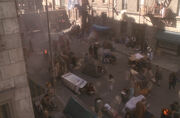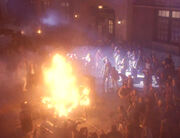| Line 29: | Line 29: | ||
As even [[Benjamin Sisko]] admitted, economic conditions were so bad that they could not be changed overnight, and there were no new jobs to simply give to the Sanctuary District residents. Even so, social and governmental elements had simply stopped trying, feeling that their economic problems were too big to ever fix. |
As even [[Benjamin Sisko]] admitted, economic conditions were so bad that they could not be changed overnight, and there were no new jobs to simply give to the Sanctuary District residents. Even so, social and governmental elements had simply stopped trying, feeling that their economic problems were too big to ever fix. |
||
| − | + | == The Bell Riots == |
|
[[File:Bell Riots.jpg|thumb|The Bell Riots begin]] |
[[File:Bell Riots.jpg|thumb|The Bell Riots begin]] |
||
On [[September|September 1]], [[2024]], residents of [[Sanctuary District A]] in [[San Francisco]] took over an [[Sanctuary Processing Center|administrative processing center]], holding six employees hostage and gaining access to the planetary computer network in order to broadcast their stories to the world. |
On [[September|September 1]], [[2024]], residents of [[Sanctuary District A]] in [[San Francisco]] took over an [[Sanctuary Processing Center|administrative processing center]], holding six employees hostage and gaining access to the planetary computer network in order to broadcast their stories to the world. |
||
Revision as of 02:57, 11 June 2012

Sanctuary District A in San Francisco, shortly before the Bell Riots.
A Sanctuary District was a section of a city designated for the homeless and unemployed of the United States of America in the early 21st century.
History
Sanctuary districts were created by the American government reacting to a serious social and economic problems occurring during the early 21st century. By the early 2020s, every major city in the United States had one.
They were originally established as places of sanctuary for those without jobs or homes. Many people entered the districts voluntarily because of the promise that the administration would get them jobs. People with mental health problems also ended up placed there since the government could not pay to put them in hospitals. People with a Police record were not allowed.
Despite the benevolent intent, conditions inside the camps had quickly degenerated to the point that by 2024 over-crowding was chronic, and since inhabitants were legally disallowed to leave "for their own protection", internment in the districts amounted to nothing less than imprisonment. Sanctuary Districts did provide an unemployment office so that residents could apply for jobs in mainstream society, and in theory, once a resident was hired for a job, they would be allowed to leave. By 2024, with employment levels at record lows with no end in sight, residents rarely if ever obtained the employment opportunities they were promised, de facto guaranteeing that the "residents" of the Sanctuary Districts were in fact life-long "prisoners" detained without due process. Sanctuary Districts had become essentially the return of medieval debtors' prisons.
Perhaps most shockingly, even children were imprisoned without Sanctuary Districts. Due to the breakdown of social services, when children lived with parents who became unemployed, rather than putting the children into some form of foster care or orphanages, instead the entire family was detained in a Sanctuary District. The streets of a crowded Sanctuary District would be filled with the noises of children playing in the street, without any form of institutional support on the inside such as schools. The Sanctuary Districts were meant as a stop-gap measure, but on a long term basis, this meant that children growing up uneducated on the inside had even less of a chance of finding employment than their parents.
Sometime prior to 2024, the Federal Employment Act of 1946 was repealed, which had stated that, at least in theory, the United States government bore the responsibility for unemployment and ensuring economic stability in the country. Symbolically, this meant that society had washed its hands of responsibility for combating the endemic poverty resulting from a global economic depression.
Operation and living conditions
If someone could not provide a ID and proof of employment, they would be forcibly relocated to the Sanctuary District. New arrivals would be brought to a processing station, where they were identified and registered. Typical processing of internees consisted of response to a questionnaire to determine whether the internee was a "dim" (mentally ill), or a "gimmie" (unemployed). Despite these slang classifications there was little difference in how internees were treated once they were processed into the camps. A resident that turned hostile in the district was called a "ghost".
Physically, the Sanctuary Districts were what used to be run-down neighborhoods of major cities, which were closed off by erecting cement perimeter walls, literally separating the rich from the poor. Within the Sanctuary District itself no one actually owned a specific building or property, as in theory they "belonged to everyone". In practice, this meant that people detained inside the districts lived as squatters, with the strong pushing the weak onto the street. Even comparatively well-organized buildings, defended by local gangs, suffered from rampant overcrowding, with so many people simply squatting in hallways that it was difficult to move. On the streets, crude shantytowns were erected with people living in tents, or some families literally living out of cardboard boxes. Security guards - the Sanctuary District Police - were over-stretched and underpaid, and while they did some basic patrols this did little to curb internal violence, and their main job was simply to keep people from trying to escape. Essentially, the "solution" to poverty and homelessness by the early 2020s was to wall off a poor neighborhood, round up all of the poor from the rest of the city and randomly dump them inside the walls, and then shoot anyone that tried to leave.
Food was rationed, but even with those measures there were regular shortages. Additionally, medical treatment, both physical and mental, was inaccessible, and the threat of physical violence from other inmates or the cynical and hardened guards was a constant threat. Even so, many people seeking to hide from law enforcement, creditors, or other social elements sought to lose themselves in the hidden depths of the Sanctuaries, often aided by the administrative staffs who felt sympathy for them, despite the conditions of the camps.
Reaction
The upper classes of the United States had convinced themselves that they had actually solved their nation's social and economic problems, with the Sanctuary Districts serving as a means to "sweep under the rug" people who were suffering economically, and simply ignore them.
As even Benjamin Sisko admitted, economic conditions were so bad that they could not be changed overnight, and there were no new jobs to simply give to the Sanctuary District residents. Even so, social and governmental elements had simply stopped trying, feeling that their economic problems were too big to ever fix.
The Bell Riots

The Bell Riots begin
On September 1, 2024, residents of Sanctuary District A in San Francisco took over an administrative processing center, holding six employees hostage and gaining access to the planetary computer network in order to broadcast their stories to the world.
The Bell Riots, as they were later named, after protest leader Gabriel Bell, ended when the governor of California ordered National Guard troops to retake the processing center by force. Hundreds of sanctuary residents were killed, including Bell himself, although none of the hostages were harmed. During the riots, there were also disturbances in other sanctuary districts.
Before the riots, the public had mostly remained unaware of how bad the conditions were in sanctuary districts, as their records were not posted on the net. But in the wake of the Bell Riots and the senseless deaths of so many people, American public opinion turned against the Sanctuary policy, and the districts were abolished. By the 24th century the Sanctuary Districts were seen as amongst the worst mistakes of the 21st century. (DS9: "Past Tense, Part I", "Past Tense, Part II")
